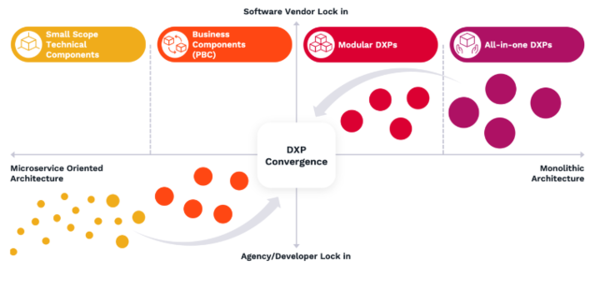How do Composable DXPs fit into the MACH Architecture trend?

As more and more companies consider ridding themselves of monolithic and legacy platforms, they are looking towards modern approaches. According to Gartner®: “CIOs are accelerating IT investments as they recognize the importance of flexibility and agility in responding to disruption.” However, while microservices, APIs, cloud-native software, and headless are essential building blocks for a modern tech stack, they aren't the only things a modern business organization might need or consider. So, are you really considering every possibility for your journey toward full composability for your digital transformation?
Business organizations searching to be agile and nimble with the proper foundation for their tech stacks will undoubtedly hear about modular or composable DXPs and MACH-architecture solutions. However, there may still be questions about what they are, how they fit together, and whether they can even co-exist. Let's look into it and start with a few clarifications:
What Is a Modular or Composable DXP?
Digital Experience Platforms (DXPs) support organizations in composing, managing, and optimizing digital experiences. DXPs are built to manage our multichannel world and provide an integrated set of tools to help marketers, e-commerce managers, developers, and others throughout the organization to orchestrate better digital customer experiences.
There are two categories of DXPs, Monolithic DXPs, and modular or composable DXPs. Their differences are crucial for understanding how modular DXPs and MACH can co-exist.
- Monolithic DXPs are suite tools that offer various tools as a complete package. These different services are all managed by a single vendor, which often leads to increased complexity and difficulty integrating with tools outside the suite.
- Modular or Composable DXPs, on the other hand, are Digital Experience Platforms built from a set of easily integrated best-of-breed tools. Modular DXPs provide more flexibility and customizability than Monolithic DXPs since they follow a modular architecture. With this approach, various tools can be combined using APIs, allowing them to create impactful and compelling digital experiences.
Ibexa DXP is a modular DXP. It is not based on a monolithic architecture but on the assembly of decoupled components that can be used independently (if desired). It is a good fit for companies that want to grow with a solution without necessarily having the developing power by working together through APIs and microservices with a headless approach. For more information about The Convergence of Digital Experience Platforms (DXP)., check out the blog post by our CEO, Bertrand Maugain.
What makes Ibexa a Modular DXP?
Modular DXPs allow business organizations to choose only the functionality and software they want to implement. This will enable them only to select the software they need and that fits their specific business requirements. From a more technical perspective, a modular solution like Ibexa DXP can be built from various systems connected with APIs and microservices. And one of the benefits of this approach is that it allows organizations to integrate already existing systems within their business. However, there are other benefits worth mentioning:
- Flexibility. Ibexa DXP brings flexibility to companies with high-complexity businesses by integrating different technologies, such as a new marketing automation engine or a CRM. It allows you to integrate with any new software to fulfill new or changing requirements. And it provides all the flexibility to scale up or down your applications for better customer experiences.
- Customer Centered. With Ibexa DXP, you can apply better customer data and control every touchpoint, thus delivering an impactful experience. To do that, you can leverage Ibexa Personalization, integrate Ibexa CDP, or another third-party tool to increase the segmentation and personalization of your content.
- Quick Implementation. In today's digital world, speed is essential; the faster the time-to-market, the more opportunity businesses have to capture a significant portion of the market share and shape customer perception. Ibexa DXP enables you to implement new components and experiences rapidly and seamlessly.
A modular DXP allows any business organization to quickly adapt to technology and customer trends to deliver the best customer experience possible. For any organization looking for a flexible and adaptable platform, a modular DXP like Ibexa is an excellent choice. Now that we have explained the benefits of modular DXPs let's talk about the MACH architecture.
What Is MACH architecture?
MACH architecture is a set of principles that center around the ethos of composability, where more specialized vendors deliver better interoperability for faster integrations. Its value lies in selecting only the components you need for your business and quickly integrating them with the help of front-end developers. This is a less unified option than the modular DXP but can be immensely powerful and valuable from an agility perspective. The acronym stands for Microservices, API-first, Cloud-native, and Headless. Let’s break these down a bit further:
- Microservices. These independent, modular business components facilitate communication through flexible APIs, breaking software applications into minor modular services.
- API-first. Components are built in an API-first approach to ensure connectivity and integration possibilities to create the required composable DXP architecture. This allows these systems to integrate with other best-of-breed tools to build a flexible tech stack.
- Cloud-native. Cloud-Native represents applications or services that use the PaaS model to deliver functionalities, enabling scalability in the process and automatic updates.
- Headless. The Headless approach enables complete design and front-end implementation freedom to create the user interface and connect to other channels and devices.
What Does a Modular DXP Have in Common with the MACH?
As mentioned earlier, Ibexa DXP is built on modularity. By being modular, Ibexa DXP follows the same principles as the MACH architecture, offering similar business outcomes by seamlessly connecting other vital components or apps and composing any necessary packaged business application. These modules can then be reused and updated as needed through APIs and microservices. This approach to software architecture makes it easier for business organizations to create and manage experiences that meet their business requirements and customer needs.
In fact, Ibexa DXP can take MACH architecture principles a step further while also promoting organizational agility and efficiency. We will use the MACH acronym to explain:
Microservices
Ibexa DXP is the result of multiple active modules that you can find in each product offering: Ibexa Content, Ibexa Experience, and Ibexa Commerce. It operates seamlessly in a services-oriented architecture by interfacing with specialized microservices, enterprise back-office systems (like CRM, ERP, WMS, etc.), and front ends like JavaScript-driven web apps or mobile applications.
Ibexa goes where you want to go with the desired modularity of the platform, allowing you to develop, update, and scale specific and independent platform services with minimal impact and risk to its overall implementation. It enables you to choose technologies - both existing tech investments and emerging requirements - as needed, and it also allows you to add or replace systems and services independently.
API-First
Ibexa DXP has been API-first since its inception. It is standardized on REST and GraphQL, offering extension points to build custom endpoints and a built-in Playground for GraphQL. It makes it easy for developers to innovate in the front-end framework of their choice by enabling them to build robust, high-impact features, leveraging existing data and technology infrastructure with powerful integrations by optimizing existing capabilities. Its API-first approach delivers:
- Deep interoperability capabilities with key business technologies and systems.
- Quick scale and deployment of solutions for new technology and channels to support new revenue model opportunities.
- The use of an extensive library of comprehensive knowledge repositories offering quality technical documentation.
In addition, Ibexa DXP is built on Symfony, the number one framework for PHP that powers a very big portion of the modern web. This makes Ibexa DXP very easy to connect with any component (aka bundles) in the Symfony ecosystem. And, with its API-first design, which is the core of the Symfony framework, you will be more than ready to build any microservice or modular component to elevate your customer experiences for the modern web and beyond.
Cloud-First
Ibexa is ready for deployment on common cloud stacks and enables you to build a cloud architecture according to your needs on AWS, Azure, Google Cloud… or even on-premise. Functionality and infrastructure improvements appear continuously over time. This allows Ibexa to stay independent while letting you focus on your customer experience and the development of the application.
As part of the Ibexa DXP modular experience, we also offer Ibexa Cloud. An optional, agile, and cost-effective cloud hosting platform and PaaS service allowing you to increase your digital infrastructure investment at your own pace. This means you can build your DXP modularly with Ibexa Content, Ibexa Experience, Ibexa Commerce, and Ibexa Personalization as and when your business needs them. It also provides a cost-benefit over IaaS providers by reducing the personnel cost of running your own internal DevOps team.
Headless
Ibexa DXP can be entirely headless, full-stack, or hybrid. It is ultimately up to you. At Ibexa, you can choose which way you want your DXP to be, this is because our product infrastructure allows us to build our internal APIs and then expose them through web APIs such as REST or GraphQL.
It offers you the same agility as in a MACH architecture, but with a twist, since it is also built for traditional visual content authoring from its inception, making it a true hybrid platform by design. For example, Ibexa Content is a fully-fledged Headless CMS, it is flexible, and its features are complete with a granular permission system, workflows, extensive metadata (including a tree structure), rich media management, and much more. We must also mention that the Ibexa DXP content modeling architecture has been battle tested in complex real-world scenarios for more than two decades, so complexity won’t be a problem.
The Same Composability and Agility
The principles of the MACH architecture are the same principles adopted by Ibexa. This makes Ibexa DXP very MACH architecture-friendly by having the same understanding regarding composability and agility:
Flexibility. Adaptability is a necessity in the modern business world. Ibexa DXP follows the same processes of any MACH-based DXP solution and provides all the flexibility required to respond to fast changes in the market without placing restrictions on those using the platform.
Best-of-Breed Selection. Business organizations can choose from any of the top tools on the market to stay competitive and remain flexible. Ibexa DXP is adaptable, agile, and designed to allow the addition, testing, and removal of tailor-made systems built with the best technology available.
Faster Speed to Market. By leveraging an extremely agile architecture, Ibexa DXP enables B2B businesses to release new products and campaigns to market more quickly. Business organizations can build and launch MVPs faster and get customer feedback.
Future-proof Architecture. As new tools and technologies are released, Ibexa DXP allows business organizations to stop wondering if they should re-platform or make another purchase, as its composable architecture is future-proof.
Omnichannel Delivery. Customer experiences are most effective when well-orchestrated. Marketers need the flexibility to preview, edit and personalize every customer experience. Ibexa can act as a content repository, delivery tier, and integration point; you only need to choose the option you need and the level of customization.
Personalization, Targeting & Omnichannel. Ibexa embraces granular personalization and enables personalized content variations for several different audiences regardless of the type of content, application, or channel. And it can take the personalization and targeting process even further by using external data from your marketing automation, digital asset management, CRM system, or our very own Ibexa CDP.
Unified Admin Experience & Predictable Costs. Ibexa DXP will enable you to scale according to your needs, pace your investment and avoid unpredictable costs. By dealing with one primary vendor, it is much easier to implement specific needs and identify critical responsibilities allowing you to concentrate on the actual business requirements instead of focusing on coming up with complex processes and architectures at the technical level.
In the end, it is a Matter of Choice…
The promises made by the promoters of the MACH movement are honest, engaging, and value-added. And while it’s a relatively new term in the industry, the MACH architecture is quickly gaining popularity for how it helps business organizations by giving them the freedom to choose the best tools on the market while maintaining a structure that makes it easy to add, replace, or remove them if necessary.
However, a modular or composable DXP solution like Ibexa DXP is just as easy, if not easier, to understand, plan and implement than a system broken down into many separate microservices like MACH architecture. It enables the creation of a composable and fully integrated solution combining any best-of-breed tools a high-complexity company may require. Its API-first approach can be fully integrated with any additional software tool, including platforms for e-commerce, analytics, and Digital Asset Management, seriously simplifying a company's application management as well as deployment processes and operations costs.
At Ibexa, we strongly believe in an API-first, component-based DXP that enables customers and partners to accelerate development with an ideal balance between software and implementation. We have a long history of designing, implementing, maintaining, and evolving "composed," rich, headless, API-based e-commerce architectures in the cloud.
We've mastered its data repositories exposed in real-time APIs to offer our customers an architectural framework that allows authentic omnichannel customer experiences. With our several available APIs, our DXP can communicate with any external application, providing great flexibility and perfectly adapting to any business need and requirement, delivering fantastic customer experiences on any channel. And it allows Ibexa to understand a customer's full complexity and serve them with complete modularity and discerning agility.
[1] Gartner Press release, April 6, 2022, Gartner Forecasts Worldwide IT Spending to Reach $4.4 Trillion in 2022 https://www.gartner.com/en/newsroom/press-releases/2022-04-06-gartner-forecasts-worldwide-it-spending-to-reach-4-point-four-trillion-in-2022. GARTNER is a registered trademark and service mark of Gartner, Inc. and/or its affiliates in the U.S. and internationally and is used herein with permission. All rights reserved

